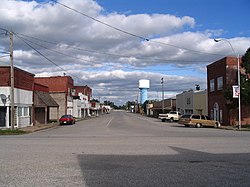Commerce, Oklahoma
| Commerce, Oklahoma | |
|---|---|
| City | |

Downtown Commerce, looking eastward down Main Street
|
|
 Location within Ottawa County and the state of Oklahoma |
|
| Coordinates: 36°56′1″N 94°52′17″W / 36.93361°N 94.87139°WCoordinates: 36°56′1″N 94°52′17″W / 36.93361°N 94.87139°W | |
| Country | United States |
| State | Oklahoma |
| County | Ottawa |
| City | March 5, 1918 |
| Named for | Commerce Mining and Royalty Company |
| Government | |
| • Mayor | Michael R Hart (V) |
| • Council Members | Sharon Tompkins, Lena Enochs, Sandra Ross, and Jim Long |
| Area | |
| • Total | 0.8 sq mi (2.1 km2) |
| • Land | 0.8 sq mi (2.1 km2) |
| • Water | 0.0 sq mi (0.0 km2) |
| Elevation | 810 ft (247 m) |
| Population (2010) | |
| • Total | 2,473 |
| • Density | 3,232.2/sq mi (1,248.0/km2) |
| Time zone | Central (CST) (UTC-6) |
| • Summer (DST) | CDT (UTC-5) |
| ZIP code | 74339 |
| Area code(s) | 539/918 |
| FIPS code | 40-16500 |
| GNIS feature ID | 1091596 |
| Website | commerceokla.com |
Commerce is a city in Ottawa County, Oklahoma, United States. The population was 2,473 at the 2010 census, down 6.5 percent from 2,645 at the 2000 census. and below the peak of 2,555 residents it had had in 1920. Commerce is included in the Joplin, Missouri metropolitan area
What became Commerce was land that was part of the Quapaw Indian Agency, allocated in the late 1830s. The Quapaw were removed to the area in the 1830s by the federal government after residing for hundreds of years on the west side of the Mississippi River in what later entered the union as the state of Arkansas.
Immigrants arrived and formed a mining camp named Hattonville after Amos Hatton. In 1906, Hatton developed the Emma Gordon zinc and lead mine, whose resources had attracted workers. Starting in 1908, the Oklahoma, Kansas and Missouri Inter-Urban Railway built a line between Miami and Commerce to serve the mining industry. In a series of steps the line was later acquired by the St. Louis–San Francisco Railway. In 1913, the residents called the local post office North Miami, though by June 1914 the post office took the present-day city's name that came from the Commerce Mining and Royalty Company, which had bought the mining camp.
In 1914, the mining company platted the town; a mayor–council government formed two years later. By the 1920 census, Commerce had a population of 2,555.
...
Wikipedia
